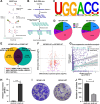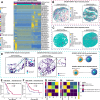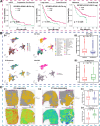Multi-omics analysis unveils the predictive value of IGF2BP3/SPHK1 signaling in cancer stem cells for prognosis and immunotherapeutic response in muscle-invasive bladder cancer
- PMID: 39367493
- PMCID: PMC11452965
- DOI: 10.1186/s12967-024-05685-8
Multi-omics analysis unveils the predictive value of IGF2BP3/SPHK1 signaling in cancer stem cells for prognosis and immunotherapeutic response in muscle-invasive bladder cancer
Erratum in
-
Correction: Multi-omics analysis unveils the predictive value of IGF2BP3/SPHK1 signaling in cancer stem cells for prognosis and immunotherapeutic response in muscle-invasive bladder cancer.J Transl Med. 2025 Aug 14;23(1):909. doi: 10.1186/s12967-025-06717-7. J Transl Med. 2025. PMID: 40814125 Free PMC article. No abstract available.
Abstract
Background: Muscle invasive bladder cancer (MIBC) is a life-threatening malignant tumor characterized by high metastasis rates, poor prognosis, and limited treatment options. Immune checkpoint inhibitors (ICIs) targeting PD-1 and PD-L1 represent an emerging treatment for MIBC immunotherapy. However, the characteristics of patients likely to benefit from immunotherapy remain unclear.
Methods: We performed single-cell mass cytometry (CyTOF) analysis of 179,483 single cells to characterize potential immunotherapy-related cancer stem cells (CSCs)-like populations in the tumor microenvironment of 38 MIBC tissues. The upregulated expression of IGF2BP3 in CD274 + ALDH + CSC-like cells, which was associated with poor clinical prognosis, was analyzed by bulk RNA-sequencing data from an in-house cohort. The functional role of IGF2BP3 was determined through cell proliferation, colony formation, cell apoptosis and sphere formation assays. The regulation of SPHK1 expression by IGF2BP3 was investigated using methylated RNA immunoprecipitation sequencing (MeRIP-seq) and bulk RNA-sequencing (bulk RNA-seq). We further utilized single-nucleus RNA sequencing (snRNA-seq) data from 67,988 cells of 25 MIBC tissues and single-cell RNA sequencing (scRNA-seq) data from MIBC patient-derived organoids to characterize the molecular features of bladder cancer cells co-expressing IGF2BP3 and SPHK1. Spatial transcriptomics (ST) and co-detection by indexing (CODEX) analysis were used to describe the spatial distribution and interactions of IGF2BP3 + SPHK1 + bladder cancer cells and immune cells.
Results: A subset of CD274 + ALDH + CSC-like cells was identified, associating with immunosuppression and low survival rates in MIBC patients. IGF2BP3, an m6A reader gene, was found to be upregulated in the CD274 + ALDH + CSC-like cell population and linked to poor clinical prognosis in MIBC. Knockout of IGF2BP3 dramatically promoted cell apoptosis and reduced cell proliferation in T24 cells. By integrating MeRIP-seq and bulk RNA-seq analyses, we identified SPHK1 served as a substrate for IGF2BP3 in an m6A-dependent manner. Further snRNA-seq, scRNA-seq, ST, and CODEX analysis revealed a closer topographical distance between IGF2BP3 + SPHK1 + bladder cancer cells and exhausted CD8 + T cells, providing one explanation for the superior response to immunotherapy in IGF2BP3 + SPHK1 + bladder cancer cells-enriched patients. Finally, an ICI-associated signature was developed based on the enriched genes of IGF2BP3 + SPHK1 + bladder cancer cells, and its potential ability to predict the response to immunotherapy was validated in two independent immunotherapy cohort.
Conclusions: Our study highlighted the critical involvement of the IGF2BP3/SPHK1 signaling in maintaining the stemness of CSCs and promoting MIBC progression. Additionally, these findings suggested that the IGF2BP3/SPHK1 signaling might serve as a biomarker for prognosis and immunotherapy response in MIBC.
Keywords: Cancer stem cells; IGF2BP3; Immunotherapy; Muscle invasive bladder cancer; SPHK1.
© 2024. The Author(s).
Conflict of interest statement
The authors have declared no competing interests.
Figures








Similar articles
-
Interplay between tumor mutation burden and the tumor microenvironment predicts the prognosis of pan-cancer anti-PD-1/PD-L1 therapy.Front Immunol. 2025 Jul 24;16:1557461. doi: 10.3389/fimmu.2025.1557461. eCollection 2025. Front Immunol. 2025. PMID: 40777041 Free PMC article.
-
SIGMAR1 screened by a GPCR-related classifier regulates endoplasmic reticulum stress in bladder cancer.J Transl Med. 2025 Apr 10;23(1):417. doi: 10.1186/s12967-025-06393-7. J Transl Med. 2025. PMID: 40211230 Free PMC article.
-
The N6-methyladenosine reader IGF2BP3 promotes bladder cancer progression through enhancing HSP90AB1 expression.FEBS J. 2025 Jul;292(13):3477-3493. doi: 10.1111/febs.70068. Epub 2025 Mar 19. FEBS J. 2025. PMID: 40105114 Free PMC article.
-
Systemic treatments for metastatic cutaneous melanoma.Cochrane Database Syst Rev. 2018 Feb 6;2(2):CD011123. doi: 10.1002/14651858.CD011123.pub2. Cochrane Database Syst Rev. 2018. PMID: 29405038 Free PMC article.
-
Circulating tumor DNA as a Predictive and Prognostic Biomarker in the Perioperative Treatment of Muscle-invasive Bladder Cancer: A Systematic Review.Eur Urol Oncol. 2024 Feb;7(1):44-52. doi: 10.1016/j.euo.2023.05.012. Epub 2023 Jun 15. Eur Urol Oncol. 2024. PMID: 37330413
Cited by
-
Detection of Cancer Stem Cells from Patient Samples.Cells. 2025 Jan 20;14(2):148. doi: 10.3390/cells14020148. Cells. 2025. PMID: 39851576 Free PMC article. Review.
-
Correction: Multi-omics analysis unveils the predictive value of IGF2BP3/SPHK1 signaling in cancer stem cells for prognosis and immunotherapeutic response in muscle-invasive bladder cancer.J Transl Med. 2025 Aug 14;23(1):909. doi: 10.1186/s12967-025-06717-7. J Transl Med. 2025. PMID: 40814125 Free PMC article. No abstract available.
-
Cancer stem cells in personalized therapy: mechanisms, microenvironment crosstalk, and therapeutic vulnerabilities.Front Cell Dev Biol. 2025 Jul 30;13:1619597. doi: 10.3389/fcell.2025.1619597. eCollection 2025. Front Cell Dev Biol. 2025. PMID: 40809695 Free PMC article. Review.
-
The role and clinical potential of RNA modifications in bladder cancer.Bladder (San Franc). 2025 Mar 6;12(1):e21200037. doi: 10.14440/bladder.2024.0062. eCollection 2025. Bladder (San Franc). 2025. PMID: 40747121 Free PMC article. Review.
References
-
- Lobo N, Afferi L, Moschini M, Mostafid H, Porten S, Psutka SP, Gupta S, Smith AB, Williams SB, Lotan Y. Epidemiology, screening, and prevention of bladder cancer. Eur Urol Oncol. 2022;5:628–39. - PubMed
-
- van Hoogstraten LMC, Vrieling A, van der Heijden AG, Kogevinas M, Richters A, Kiemeney LA. Global trends in the epidemiology of bladder cancer: challenges for public health and clinical practice. Nat Rev Clin Oncol. 2023;20:287–304. - PubMed
-
- Sung H, Ferlay J, Siegel RL, Laversanne M, Soerjomataram I, Jemal A, Bray F. Global Cancer Statistics 2020: GLOBOCAN estimates of incidence and mortality worldwide for 36 cancers in 185 countries. CA Cancer J Clin. 2021;71:209–49. - PubMed
-
- Babjuk M, Burger M, Capoun O, Cohen D, Compérat EM, Dominguez Escrig JL, Gontero P, Liedberg F, Masson-Lecomte A, Mostafid AH, et al. European Association of Urology guidelines on non-muscle-invasive bladder cancer (Ta, T1, and carcinoma in situ). Eur Urol. 2022;81:75–94. - PubMed
MeSH terms
Substances
Grants and funding
- 82160501/Innovative Research Group Project of the National Natural Science Foundation of China
- AD22035042/Specific Research Project of Guangxi for Research Bases and Talents
- AB23026002/Specific Research Project of Guangxi for Research Bases and Talents
- 82060512/National Natural Science Foundation of China
- 82060460/National Natural Science Foundation of China
LinkOut - more resources
Full Text Sources
Medical
Research Materials

